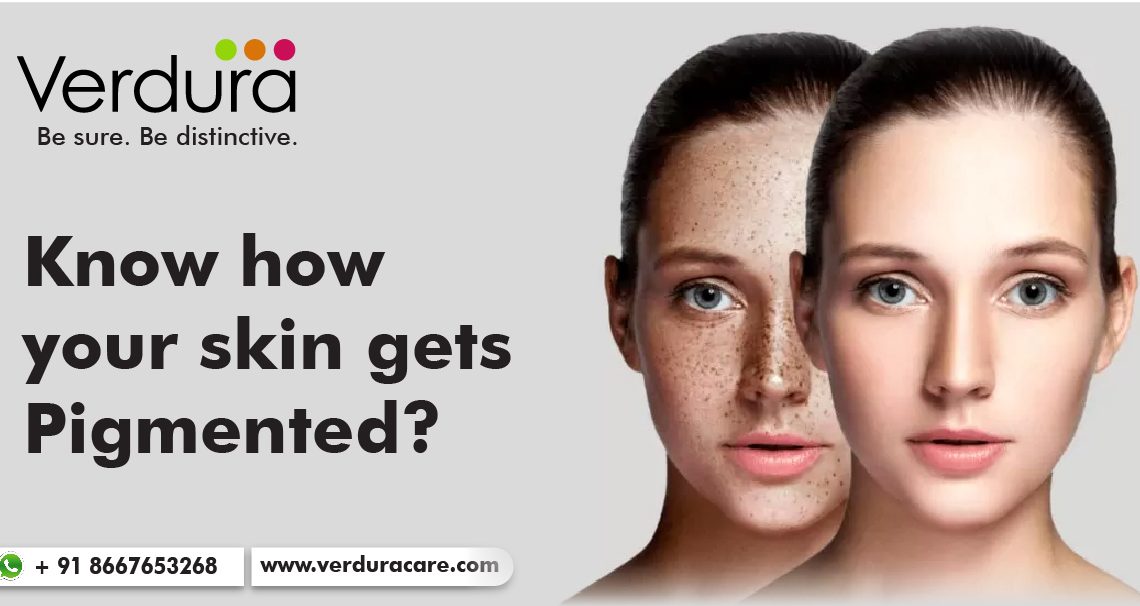

The human skin is a remarkable organ that comes in various shades, tones, and colors. The phenomenon of pigmentation is responsible for this beautiful diversity. From fair to dark, the colors we see on our skin are a result of a complex process that occurs within our bodies. In this blog, we will delve into the fascinating world of pigmentation and explore the mechanisms behind how our skin gets its unique coloration.
Understanding Pigmentation
Pigmentation is the natural coloring of the skin, hair, and eyes, primarily influenced by the presence of a pigment called melanin. Melanin is produced by specialized cells called melanocytes, which are found in the basal layer of the epidermis, the outermost layer of the skin. The amount and type of melanin present determine the color of an individual’s skin.
Key Factors Influencing Skin Pigmentation
- Melanin: Melanin is the primary pigment responsible for skin coloration. It exists in two forms: eumelanin (brown to black pigment) and pheomelanin (yellow to red pigment). The ratio and distribution of these two pigments determine the variations in skin tones.
- Melanocytes: These specialized cells produce melanin through a process known as melanogenesis. Melanocytes contain organelles called melanosomes, which are responsible for the synthesis, storage, and transportation of melanin to neighboring skin cells.
- Genetics: Genetic factors play a crucial role in determining the baseline skin color of an individual. Certain genes regulate the activity and distribution of melanocytes, influencing the amount of melanin produced and its distribution in the skin.
- UV Exposure: Ultraviolet (UV) radiation from the sun is a major external factor affecting skin pigmentation. When the skin is exposed to UV rays, it triggers the production of melanin as a protective mechanism against potential DNA damage caused by UV radiation. This is commonly known as tanning.
Mechanisms of Skin Pigmentation
- Melanin Synthesis: Melanogenesis begins with the conversion of an amino acid called tyrosine into a molecule called DOPA (dihydroxyphenylalanine). Several enzymatic reactions further transform DOPA into different forms of melanin, such as eumelanin and pheomelanin.
- Melanosome Transfer: Once melanin is synthesized, it is transported within melanosomes to the neighboring skin cells. This transfer process involves intricate interactions between melanocytes and keratinocytes, the predominant cells in the epidermis.
- Distribution of Melanin: The distribution of melanin within the skin is influenced by factors like genetic predisposition and hormonal changes. Melanin can be present primarily in the basal layer, leading to fair skin, or spread across multiple layers, resulting in darker skin tones.
skin pigmentation, we can also gain insight into various skin pigmentation disorders that can occur.
Skin Pigmentation Disorders
- Hyperpigmentation: Hyperpigmentation occurs when there is an excessive production or accumulation of melanin, leading to patches of darkened skin. Conditions such as melasma, post-inflammatory hyperpigmentation, and age spots are examples of hyperpigmentation disorders. Melasma, often triggered by hormonal changes, is characterized by dark patches on the face, while post-inflammatory hyperpigmentation occurs after skin inflammation or injury.
- Hypopigmentation: Hypopigmentation refers to the loss or decrease in melanin production, resulting in lighter patches of skin. Conditions like vitiligo and albinism are characterized by hypopigmentation. Vitiligo leads to the development of white patches on the skin due to the destruction of melanocytes, while albinism is a genetic disorder that affects melanin production throughout the body, resulting in very light or white skin, hair, and eyes.
Understanding these skin pigmentation disorders is crucial in providing effective treatments and support for individuals experiencing them. Dermatologists and skincare professionals can offer specialized solutions tailored to each condition, including topical treatments, laser therapy, and camouflage techniques.
Maintaining Healthy Skin Pigmentation
While we cannot alter our baseline skin color or change our genetic predisposition to pigmentation, there are steps we can take to maintain healthy and even-toned skin:
- Sun Protection: Protecting your skin from harmful UV radiation is essential in maintaining healthy pigmentation. Always wear broad-spectrum sunscreen with a high SPF, seek shade during peak sun hours, and wear protective clothing, such as hats and long sleeves, when exposed to the sun.
- Skincare Routine: Establish a skincare routine that includes gentle cleansing, moisturizing, and exfoliating. Look for skincare products with ingredients like vitamin C, niacinamide, and licorice extract, known for their brightening and pigment-regulating properties.
- Healthy Lifestyle: A balanced diet rich in antioxidants, vitamins, and minerals can support overall skin health. Stay hydrated, consume fruits and vegetables, and reduce stress levels to promote healthy skin.
- Consult a Dermatologist: If you notice any significant changes in your skin pigmentation or have concerns about specific skin conditions, it’s advisable to seek professional help from a dermatologist. They can provide accurate diagnoses, personalized advice, and targeted treatments for your specific needs.
Use Skin brite cream from verduracare your Destination to flawless blemish-free and radiant skin
A unique combo of evolved ingredients that specifically target the mechanism of pigmentation, resulting in spotless, clear and glowing skin.
This cream to remove dark spots is a safe bet for anyone seeking remarkable results. It is suitable for all skin types and comes in a lightweight, non-greasy formula.
Skin pigmentation is a complex and captivating process that determines the beautiful array of colors seen in the human population. From the synthesis and distribution of melanin to the interplay of genetic and environmental factors, our skin pigmentation is a unique reflection of our individuality.
Understanding how pigmentation works empowers us to appreciate and care for our skin better. By embracing diversity, raising awareness about skin pigmentation disorders, and practicing healthy skincare habits, we can foster a society that celebrates the beauty of all skin tones.



